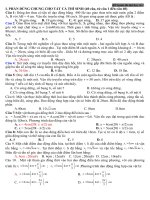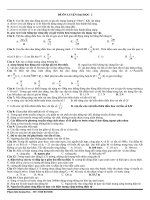CHUYÊN ĐỀ 3. CÂU TRỰC TIẾP, GIÁN TIẾP VÀ CÂU CHỦ ĐỘNG, BỊ ĐỘNG (CHUYÊN ĐỀ ÔN THI ĐẠI HỌC CỦA CÔ VŨ THỊ MAI PHƯƠNG)
Bạn đang xem bản rút gọn của tài liệu. Xem và tải ngay bản đầy đủ của tài liệu tại đây (1.37 MB, 30 trang )
Khóa học LTðH môn Tiếng Anh – Giáo viên: Vũ Thị Mai Phương
Câu trực tiếp, gián tiếp và chữa bài tậ
p có liên quan
Hocmai.vn – Ngôi trường chung của học trò Việt
Tổng ñài tư vấn: 1900 58-58-12
- Trang | 1
-
I. GIỚI THIỆU
Khi thuật lại lời nói của người khác, ta có thể nhắc lại nguyên văn. Trường hợp này gọi là lời nói trực tiếp
(Direct Speech) và khi viết phải ñặt trong ngoặc kép.
Ex: Nam said, “I am going to the cinema”.
Nhưng ta cũng có thể sửa ñổi chút ít và lồng vào câu nói của mình. Trường hợp này gọi là lời nói gián tiếp
(Indirect speech).
Ex: Nam said that he was going to the cinema.
II. QUI TẮC CHUYỂN LỜI NÓI TRỰC TIẾP SANG GIÁN TIẾP
Muốn chuyển một câu trần thuật từ lời nói trực tiếp sang gián tiếp cần phải chú ý những thay ñổi sau ñây:
1. ðổi ngôi thứ của ñại từ nhân xưng, tính từ và ñại từ sở hữu cho thích hợp.
Ex:
DIRECT INDIRECT
I am going to repair your bicycle;
you can take mine.
We did the work ourselves.
Nam told me that he was going to
repair my bicycle and I could take his.
They said that they had done the work
themselves.
2. Nếu nhắc lại lời nói trong quá khứ và dùng ñộng từ ở thì quá khứ trong mệnh ñề chính (He
said…; they told…) thì ñộng từ trong lời nói gián tiếp phải lùi về quá khứ một bước theo các quy tắc và thí
dụ sau ñây:
3. Thay ñổi những tính từ, phó từ hay cụm phó từ chỉ nơi chốn, thời gian… cho thích hợp,
theo những quy tắc và thí dụ sau ñây.
DIRECT INDIRECT
This, these, here, now, today,
tomorrow, yesterday
Three days, ago
Last week, next week
That, those, there, then, that day, the
next day, the previous day (the day
before).
Three days, before.
The previous week, the next week (the
following week).
CÂU TRỰC TIẾP, GIÁN TIẾP VÀ
CHỮA BÀI TẬP CÓ LIÊN QUAN
(TÀI LIỆU BÀI GIẢNG)
Giáo viên: VŨ THỊ MAI PHƯƠNG
Khóa học LTðH môn Tiếng Anh – Giáo viên: Vũ Thị Mai Phương
Câu trực tiếp, gián tiếp và chữa bài tậ
p có liên quan
Hocmai.vn – Ngôi trường chung của học trò Việt
Tổng ñài tư vấn: 1900 58-58-12
- Trang | 2
-
Ex:
I met the man here in this office today He said (that) he had met the man there,
in that office that day.
We spoke to him the day before
yesterday.
We shall be home tomorrow.
I will do it here and now.
He said (that) they had spoken to him
two days before.
They would be home the next day.
He would do it there and then.
Chuyển những câu sau ñây sang lời nói gián tiếp:
1. He said: “My son will be here soon”.
2. They said: “We have never been defeated”.
3. She told me: “I am going to the party with my mother”.
4. They said: “We have plenty of time to do our work”.
5. They declared: “We shall continue to fight till final victory”.
6. He told them at once: “The trains is gone, you are too late”.
7. He said: “This is the book you have been looking for”.
8. She said: “You can come with us if you like”.
9. The old man said: “I will take you to my house right now”.
10. He was still declaring: “You are the man who did it”.
11. The new was announced: “The hero is coming”.
12. She said: “I wrote to my sister only last week”.
13. The man declared: “I shall be doing exactly the same work next Monday as I am doing today”.
14. The foreigner told him: “I am French but I have learned English at school”.
15. The boy said: “I have to go to the dentist tomorrow”.
16. We were informed: “The car is ready; we shall have to get back before the clock strikes four”.
17. The librarian said: “This book was lent to him weeks ago and he has only just returned it”.
18. The girl said: “I was born in 1954 and I have been living in this small town since”.
19. They said: “We have stayed here for a month; we shall go home next week”.
20. He repeated day after day: “This climate does not suit my health; I must go away as soon as I
can”.
Chuyển những câu sau ñây sang lời nói trực tiếp. Chú ý thêm dấu chấm câu và viết hoa cho ñúng:
1. He said he was very sorry for the mistake he had made.
2. My father told me that I could go to the seaside this summer.
3. He said that the train would arrive in five minutes.
4. She said that she hoped it wouldn’t rain that morning.
5. He admitted that he had not worked so hard as his brother had done.
6. She promised her friend that she would write to her every week.
7. The boy said that he would be 18 on the 1st of May.
Khóa học LTðH môn Tiếng Anh – Giáo viên: Vũ Thị Mai Phương
Câu trực tiếp, gián tiếp và chữa bài tậ
p có liên quan
Hocmai.vn – Ngôi trường chung của học trò Việt
Tổng ñài tư vấn: 1900 58-58-12
- Trang | 3
-
8. They said that he had deserved their thanks for all be had done.
9. The manager assured them that he had would return before they left.
10. The Chairman told me he had been reading the documents all day.
11. The policemen told him they would never believe what he said.
12. All who heard this said he was speaking the truth.
III. CÂU HỎI GIÁN TIẾP
Khi chuyển câu hỏi sang lời nói gián tiếp cũng phải áp dụng những quy tắc chung như ñối với câu trân
thuật, nhưng còn chú ý thêm những ñiểm sau ñây:
1. ðộng từ trong mệnh ñề chính ñể giới thiệu lời nói gián tiếp là ask (hoặc enquire, wonder, want
to know, v.v…)
2. Từ ñể nối mệnh ñề phụ là if hoặc want to know, v.v…
3. Từ ñể nối mệnh ñề phụ là if hoặc whether ñối với câu hỏi chung và ñối với câu hỏi ñặc biệt
bắt ñầu bằng các nghi vấn what, why, v.v… thì dùng lại các từ ñó.
4. Dạng câu hỏi chuyển thành câu trần thuật do ñó không dùng các trợ ñộng từ do, did, does,
trong câu hỏi gián tiếp
Ex:
DIRECT INDIRECT
a. Câu hỏi chung
Is that boy your brother?
Can you speak Russian?
Will you come tomorrow?
Has Henry worked hard?
He asked me if (whether) that boy was
my brother.
He asked me if I could speak Russian.
He asked if I would come the next day.
He enquired whether Henry had
worked hard.
Do they understand us?
Did you see Ba yesterday?
Does she play the piano?
Shall we accept the offer.
They wondered if they understood
them.
He wanted to know if I had seen Ba the
day before.
He said if she played the piano
He wondered whether we should accept
the offer.
b. Câu hỏi ñặc biệt
What is your name?
Where does she live?
What did the teacher say?
How will it work?
How have you come back
He asked me what my name was.
He enquired where she lived.
He asked what the teacher had said.
He wondered how it would work.
She asked me why I had come back
Khóa học LTðH môn Tiếng Anh – Giáo viên: Vũ Thị Mai Phương
Câu trực tiếp, gián tiếp và chữa bài tậ
p có liên quan
Hocmai.vn – Ngôi trường chung của học trò Việt
Tổng ñài tư vấn: 1900 58-58-12
- Trang | 4
-
Who teaches you that rule? He wanted to know who taught us that
rule.
Chuyển những câu sau ñây sang lời nói gián tiếp (bắt ñầu bằng: He asked…; they enquired… v.v…)
1. What do you want, my boy?
2. Who will come to the pictures with me?
3. Is your new baby a boy or a girl, Mrs. Brown?
4. May I borrow your bicycle, Nam?
5. When will you get back from Peking, Mr. Counsellor?
6. When did they tell you that?
7. Have you seen the new film?
8. Which is the road to Long Bien Bridge?
9. How do you spell your name?
10. Did they all attend the meeting?
11. Where are they going tonight?
12. How did they travel back home?
13. Who showed enjoying yourself?
15. Does she always wear that blue dress?
16. Why does he sing so loudly?
17. Which book are you reading?
18. Ought the light to be on?
19. Will the taxi be here at seven o’clock?
20. Where has she put her hat?
IV. CÂU CẦU KHIẾN GIÁN TIẾP
Chuyển câu cầu khiến sang lời nói gián tiếp phải theo các quy tắc sau:
1. Mệnh ñề chính ñể giới thiệu phải dùng những ñộng từ như order, command, tell, ask, request…
tiếp theo là tân ngữ chỉ người ñược lệnh hay yêu cầu.
2. ðộng từ trong nguyên văn ở mức mệnh lệch phải ñổi sang dạng ñộng từ nguyên thể có to ñứng
trước. Nếu mệnh lệch ở thể phụ ñịnh thì thêm not trước to + infinitive.
DIRECT INDIRECT
Get out!
Sit down, please.
Please give us some help.
Fire
He ordered him (them) to get out.
She asked me (him) to sit down.
They requested us to give them some
help.
The office commanded the soldiers to
fire.
Don’t leave the door open.
Don’t come here tomorrow.
Don’t run away.
He asked me not to leave the door open.
He told us not come there the next day.
He ordered them not to run away.
Khóa học LTðH môn Tiếng Anh – Giáo viên: Vũ Thị Mai Phương
Câu trực tiếp, gián tiếp và chữa bài tậ
p có liên quan
Hocmai.vn – Ngôi trường chung của học trò Việt
Tổng ñài tư vấn: 1900 58-58-12
- Trang | 5
-
V. CÂU HỖN HỢP
Trường hợp phải chuyển những câu hỗn hợp gồm các loại câu trần thuật, câu hỏi và câu cầu khiến sang lời
nói gián tiếp, thì cũng phải dùng những ñộng từ thích hợp ñể giới thiệu từng phần.
Ex:
- “I am off to the pictures. Where are you going?”.
He said that he was off to the pictures and wanted to know where I was going.
- “I have left my watch on your desk. Please bring it back to me”.
He said that he had left his watch on my desk and asked me to bring it back to him.
Chuyển những câu sau ñây sang lời nói gián tiếp:
1. Go at once!
2. Have a cup of tea, please.
3. Wrap it up in a piece of paper.
4. Don’t put your elbow on the table.
5. Write your name clearly on the top.
6. Don’t wipe your dirty fingers on my clothes.
7. Wait here under the tree until the rain stops.
8. Come and see me whenever you have a few hours to spare.
9. Don’t spend all your money on food and drinks.
10. Be careful, don’t answer hastily.
11. Bring the gun into position.
12. Hurry up if you want to go out with me.
Chuyển những câu sau ñây sang lời nói gián tiếp:
1. It is cold here. Is the window open?
2. Do you think it will rain? – It is cloudy.
3. I must write some letters now. – What date is it?
4. How do you like my brother’s hat? – I bought it for him in a department store.
5. What time is it? – My watch has stopped.
6. This is the most interesting book. Have you read it?
7. Are you free tomorrow night? – I would like you to come to my party.
8. What is the matter? – You don’t look very well.
9. We are going for a walk. Would you like to come, too?
10. How far is it to Nam Dinh? I hope we can get there before dark.
Giáo viên: Vũ Thị Mai Phương
Nguồn :
Hocmai.vn









